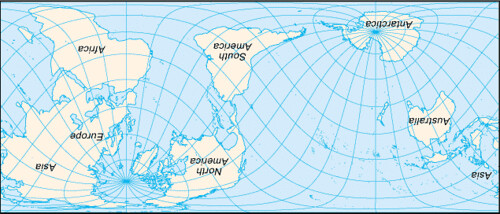(http://www.cia.gov/cia/publications/factbook/geos/xx.html).

1. UNITED STATES OF AMERICA
Consumer of cocaine shipped from Colombia through Mexico and the Caribbean; consumer of heroin, marijuana, and increasingly methamphetamine from Mexico; consumer of high-quality Southeast Asian heroin; illicit producer of cannabis, marijuana, depressants, stimulants, hallucinogens, and methamphetamine; money-laundering center.
- US INTERNATIONAL DISPUTES:
Prolonged drought, population growth, and outmoded practices and infrastructure in the border region has strained water-sharing arrangements with Mexico; undocumented nationals from Mexico and Central America continue to enter the United States illegally; 1990 Maritime Boundary Agreement in the Bering Sea still awaits Russian Duma ratification; managed maritime boundary disputes with Canada at Dixon Entrance, Beaufort Sea, Strait of Juan de Fuca, and around the disputed Machias Seal Island and North Rock; The Bahamas have not been able to agree on a maritime boundary; US Naval Base at Guantanamo Bay is leased from Cuba and only mutual agreement or US abandonment of the area can terminate the lease; Haiti claims US-administered Navassa Island; US has made no territorial claim in Antarctica (but has reserved the right to do so) and does not recognize the claims of any other state; Marshall Islands claims Wake Island (Ooooops! They forgot to mention the IRAQ INVASION!).
2. UNITED KINGDOM (UK)
Producer of limited amounts of synthetic drugs and synthetic precursor chemicals; major consumer of Southwest Asian heroin, Latin American cocaine, and synthetic drugs; money-laundering center.
3. SWITZERLAND
A major international financial center vulnerable to the layering and integration stages of money laundering; despite significant legislation and reporting requirements, secrecy rules persist and non-residents are permitted to conduct business through offshore entities and various intermediaries; transit country for and consumer of South American cocaine and Southwest Asian heroin.
4. FRANCE
Trans-shipment point for and consumer of South American cocaine, Southwest Asian heroin, and European synthetics.
5. GERMANY
Source of precursor chemicals for South American cocaine processors; trans-shipment point for and consumer of Southwest Asian heroin, Latin American cocaine, and European-produced synthetic drugs; major financial center vulnerable to the layering and integration stages of money laundering.
6. CANADA
Illicit producer of cannabis for the domestic drug market and export to US; use of hydroponics technology permits growers to plant large quantities of high-quality marijuana indoors; transit point for heroin and cocaine entering the US market; vulnerable to narcotics money laundering because of its mature financial services sector.
7. ITALY
Important gateway for and consumer of Latin American cocaine and Southwest Asian heroin entering the European market; money laundering by organized crime and from smuggling.
8. THE NETHERLANDS
Major European producer of ecstasy, illicit amphetamines, and other synthetic drugs; important gateway for cocaine, heroin, and hashish entering Europe; major source of US-bound ecstasy; large financial sector vulnerable to money laundering.
9. SPAIN
Key European gateway country for, and consumer of, Latin American cocaine and North African hashish entering the European market; destination and minor trans-shipment point for Southwest Asian heroin; money laundering site for European earnings of Colombian narcotics trafficking organizations.
10. COLOMBIA
- POLITICAL PRESSURE GROUPS:
Two largest insurgent groups active in Colombia - Revolutionary Armed Forces of Colombia or FARC and National Liberation Army or ELN; largest anti-insurgent paramilitary group is United Self-Defense Groups of Colombia or AUC.
Their operations against the Colombian Civil Society are financed through extortion, kidnapping, and mainly, illicit drugs trade, cashing in revenues from developed countries consumers. Drug trade source of instability.
Illicit producer of coca, opium poppy, and cannabis; world's leading coca cultivator (cultivation of coca in 2002 was 144,450 hectares, a 15% decline since 2001); potential production of opium between 2001 and 2002 declined by 25% to 91 metric tons; potential production of heroin declined to 11.3 metric tons; the world's largest processor of coca derivatives into cocaine; supplier of about 90% of the cocaine to the US market and the great majority of cocaine to other international drug markets; important supplier of heroin to the US market; active aerial eradication program; a significant portion of non-US narcotics proceeds are either laundered or invested in Colombia through the black market peso exchange.
11. AFGHANISTAN
World's largest producer of opium; cultivation of opium poppy reached unprecedented level of 206,700 hectares in 2004; counterdrug efforts largely unsuccessful; potential opium production of 4,950 metric tons; potential heroin production of 582 metric tons if all opium was processed; source of hashish; many narcotics-processing labs throughout the country; drug trade source of instability and some antigovernment groups profit from the trade; 80-90% of the heroin consumed in Europe comes from Afghan opium; vulnerable to narcotics money laundering through informal financial networks.
12. WORLD
Cocaine: worldwide, coca is grown on an estimated 173,450 hectares-almost exclusively in South America with 70% in Colombia; potential cocaine production during 2003 is estimated at 728 metric tons (or 835 metric tons of export quality cocaine); coca eradication programs continue in Bolivia, Colombia, and Peru; 376 metric tons of export quality cocaine are documented to have been seized in 2003, and 26 metric tons disrupted (jettisoned or destroyed); consumption of export quality cocaine is estimated to have been 800 metric tons.
Opiates: cultivation of opium poppy occurred on an estimated 137,944 hectares in 2003-mostly in Southwest and Southeast Asia-with 44% in Afghanistan, potentially produced 3,775 metric tons of opium - which conceivably could be converted to the equivalent of 429 metric tons of pure heroin; opium eradication programs have been undertaken in Afghanistan, Burma, Colombia, Mexico, Pakistan, Thailand, and Vietnam.
No comments:
Post a Comment